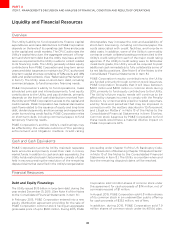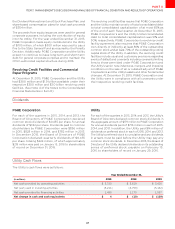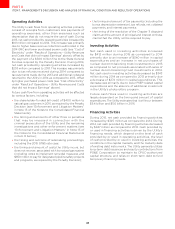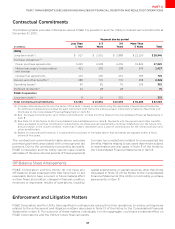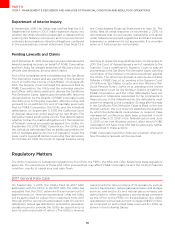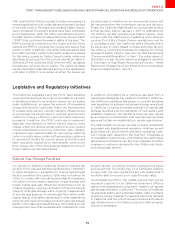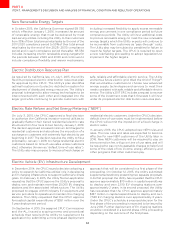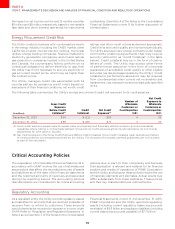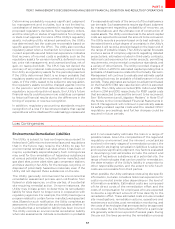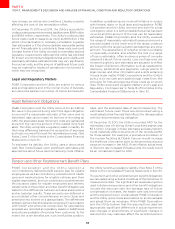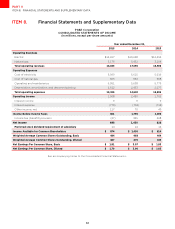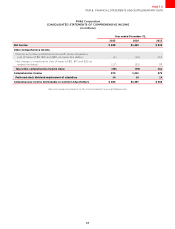PG&E 2015 Annual Report Download - page 62
Download and view the complete annual report
Please find page 62 of the 2015 PG&E annual report below. You can navigate through the pages in the report by either clicking on the pages listed below, or by using the keyword search tool below to find specific information within the annual report.
54
PART II
ITEM 7.MANAGEMENT’S DISCUSSION AND ANALYSIS OF FINANCIAL CONDITION AND RESULTS OF OPERATIONS
New Renewable Energy Targets
In October 2015, the California Governor signed SB 350
which, eective January 1, 2016, increases the amount
of renewable energy that must be delivered by most
load-serving entities, including the Utility, to their customers
from 33% of their total annual retail sales by the end of the
2017-2020 compliance period to 50% of their total annual
retail sales by the end of the 2028- 2030 compliance
period and in each compliance period thereafter. SB 350
includes increasing interim renewable energy targets for
the periods between 2020 and 2030 and continues to
include compliance flexibility and waiver mechanisms,
including increased flexibility to apply excess renewable
energy procurement in one compliance period to future
compliance periods. The Utility will incur additional costs
to procure renewable energy to meet the new renewable
energy targets which the Utility expects will continue to
be recoverable from customers as “pass-through” costs.
The Utility also may be subject to penalties for failure to
meet the higher targets. The CPUC is required to open
a new rulemaking proceeding to adopt regulations to
implement the higher targets.
Electric Distribution Resources Plan
As required by California law, on July 1, 2015, the Utility
filed its proposed electric distribution resources plan
for approval by the CPUC. The Utility’s plan identifies
optimal locations on its electric distribution system for
deployment of distributed energy resources. The Utility’s
proposal is designed to allow energy technologies to be
interconnected with each other and integrated into the
larger grid while continuing to provide customers with
safe, reliable and aordable electric service. The Utility
envisions a future electric grid, titled the Grid of Things™,
that would allow customers to choose new advanced
energy supply technologies and services to meet their
needs consistent with safe, reliable and aordable electric
service. The Utility’s 2017 GRC includes a request to recover
some of the investment costs that it forecasts it will incur
under its proposed electric distribution resources plan.
Electric Rate Reform and Net Energy Metering (“NEM”)
On July 3, 2015, the CPUC approved a final decision
to authorize the California investor–owned utilities to
gradually flatten their tiered residential electric rate
structures from four tiers to two tiers by January 1, 2019.
The decision approved increased minimum bill charges for
residential customers and also allows the imposition of a
surcharge on customers with extremely high electricity use
beginning in 2017. The decision requires the Utility to file a
proposal by January 1, 2018, to charge residential electric
customers based on time-of-use rates unless customers
elect otherwise (known as “default time-of-use rates”).
The Utility also may propose to impose a fixed charge on
residential electric customers. Under the CPUC’s decision,
default time-of-use rates must be implemented before
the CPUC will permit the imposition of a fixed charge in
electric rates.
In January 2016, the CPUC adopted new NEM rules and
rates. The new rules and rates are expected to become
eective for new NEM customers of the Utility later in
2016. New NEM customers will be required to pay an
interconnection fee, will go on time of use rates, and will
be required to pay non-bypassable charges to help fund
some of the costs of low income, energy eciency, and
other programs that other customers pay.
Electric Vehicle (EV) Infrastructure Development
In December 2014, the CPUC issued a decision adopting a
policy to expand the California utilities’ role in developing
an EV charging infrastructure to support California’s climate
goals. On February 9, 2015, the Utility filed an application
requesting that the CPUC approve the Utility’s proposal to
deploy, own, and maintain more than 25,000 EV charging
stations and the associated infrastructure. The Utility
proposed to engage with third party EV equipment and
service providers to operate and maintain the charging
stations. The Utility requested that the CPUC approve
forecasted capital expenditures of $551 million over the
5 year deployment period.
On September 4, 2015, the assigned CPUC Commissioner
and the ALJ issued a scoping memo and procedural
schedule that required the Utility to supplement its
application by submitting a more phased deployment
approach that will be considered in a first phase of the
proceeding. On October 12, 2015, the Utility submitted
supplemental testimony presenting two separate proposals.
In its first proposal, the Utility has requested that the CPUC
approve approximately $70 million in capital expenditures
to deploy and own 2,510 EV charging stations over
approximately 2 years. In its second proposal, the Utility
has requested that the CPUC approve approximately
$187 million in capital expenditures to deploy and own
7,530 EV charging stations over approximately 3 years.
Under the CPUC’s schedule, a proposed decision for the
first phase of the proceeding is expected to be issued by
June 2016. Further deployment of EV charging stations
would be considered in a second phase of the proceeding
depending on the outcome of the first phase.




